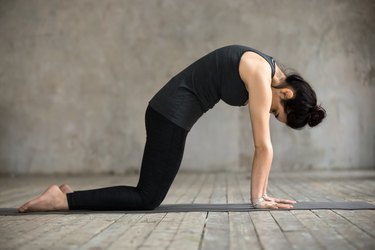
A swayback posture means that your lower back is arched, pushing your hips forwards and shoulders back. It looks like you are constantly bending backward with your upper body, hence the term "swayback."
This posture can be potentially harmful as it puts pressure on your lower back. To correct this posture, you'll need stretching, strengthening and breathing exercises.
Video of the Day
Lordosis and Anterior Pelvic Tilt
There are multiple names for swayback posture. Lordosis and anterior pelvic tilt are two scientific terms that describe the same posture. Lordosis refers to the way that the spine curves in a swayback.
Anterior pelvic tilt refers to the way that your pelvis, or hip bone, is moving. When your lower back is curved forwards it rotates your entire pelvis forward. The swayback posture isn't just a problem for your lower back, the involvement of your pelvis means it's also a problem for your hips and even your shoulders and knees.
Read More: How to Improve Your Lower Back Curve
Corrective Strategies for Swayback Posture
Swayback posture is also called lower crossed syndrome, coined by Czech physiotherapist Dr. Vladimir Janda. The name hints at why swayback posture occurs. The lower back muscles and hip flexors are tight and the abdominal and glute muscles are weak, causing the pelvis to tilt forward, according to his website. If his theory is correct, then you need to strengthen the abdominal and glute muscles and stretch the lower back and hip flexors.
The last piece of the puzzle is the muscle that allows us to breathe: the diaphragm. When your lower back is arched it puts the diaphragm out of alignment, making it difficult for you to take smooth, deep breaths. When you can't breathe properly it makes it even more difficult to maintain a proper posture. That's why it's important to practice breathing exercises in addition to strengthening and stretching muscles.
1. Stretching Swayback Exercises
These stretches target the two muscle groups whose tightness causes swayback posture: the hip flexors and lower back.
Move 1: Child's Pose
Use this yoga stretch to help relax your whole body, in particular your lower back.
- Kneel down on the ground with your butt resting on your heels.
- Reach forward with your arms and place your hands on the ground.
- Relax into the stretch and try to rest your forehead on the ground.
Move 2: Bench Hip Flexor Stretch
If you don't feel this stretch, try raising your arms over your head. Make sure you stretch both legs.
- Put the top of your back foot on a bench behind you and your knee on a soft pad.
- Plant the other foot in front of you with your knee bent, almost like a lunge position.
- Lean forward to increase the stretch.
Read More: Hip Flexor Stretches
2. Strengthening Swayback Exercises
These exercises strengthen your abdominals and glutes.
Move 1: Reverse Crunch
A reverse crunch is more effective in training the obliques when compared to a traditional crunch or sit-up, which pull your hips back, reducing the curve in your spine.
- Lie on your back on the floor in a crunch position.
- Hold a kettlebell or heavy object behind your head.
- Slowly roll your hips off of the mat, pressing your lower back down into the ground and squeezing your abs.
Move 2: Single-Leg Bridge
The single leg hip bridge variation targets one glute at a time, minimizing contribution of the lower back muscles. If the lower back muscles are too active in the movement they can take over for the glutes.
- Lie on your back with your feet planted.
- Grab one knee and pull it into your chest.
- Press down with your other foot and raise your hips off of the ground as high as you can.
Breathing Exercise for Swayback Posture
The all-4's breathing exercise will help you realign your diaphragm to help you breathe better. This is similar to the Cat pose in yoga.
- Start on the ground on your hands and knees.
- Round your back and blow out through forcefully through your mouth.
- Keep your back rounded and breathe in through your nose.
- Exhale and inhale several more times.